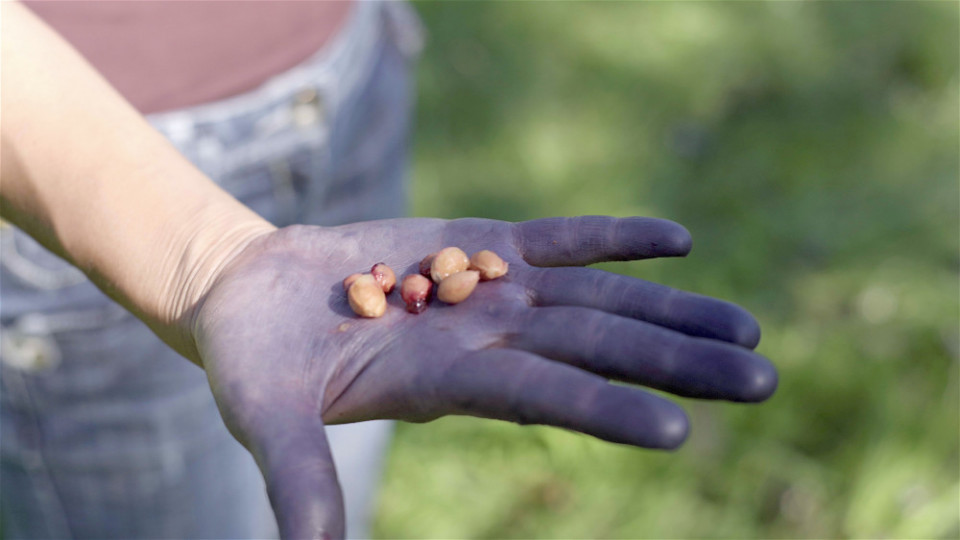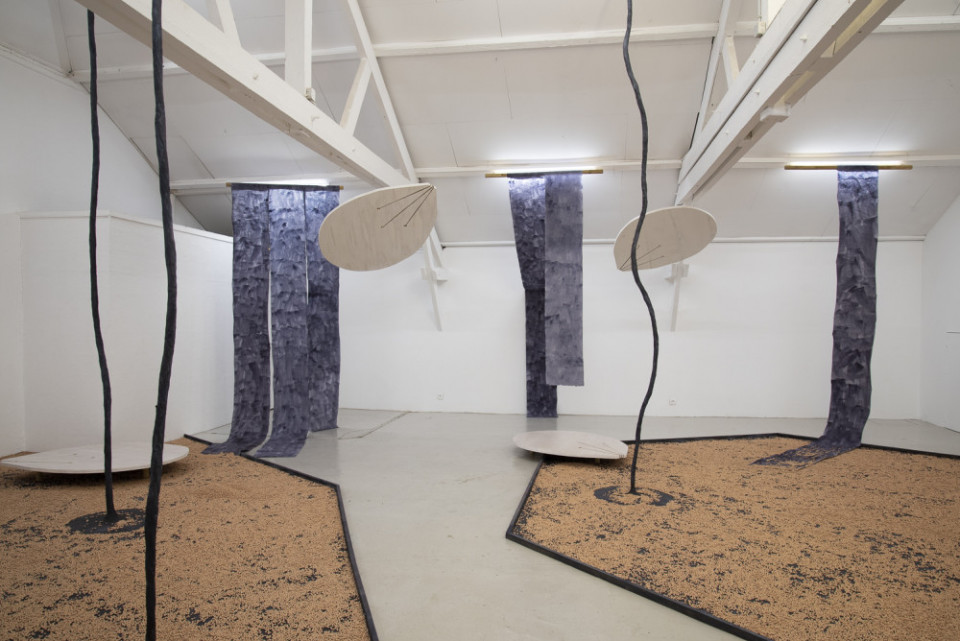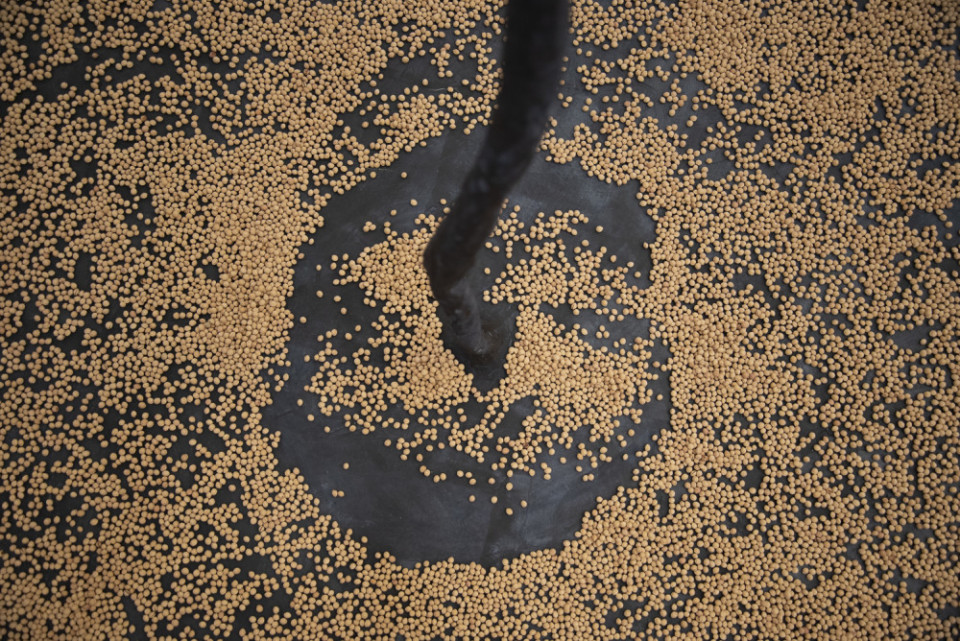Ju Hyun Lee
No cherry without pit
Exposition
“I am writing all this down in blue ink, so as to remember that all words, not just some, are written in water.”
Maggie Nelson, Bluets, Jonathan Cape (Penguin Random House), 2017
The exhibitions La Parabole du Bièvre by Suzanne Husky and Pas de cerise sans noyau by Ju Hyun Lee bring together artists’researches connected to the specific relationship between certain living beings and their environment. Although their subjects may appear to be very different (a wild species in Suzanne Husky’s work, agricultural know-how in Ju Hyun Lee’s), the two exhibitions respond to each other. Each is the product of intuitive, poetic and documented observations of the ecosystems of territories that have been disrupted by human action. They present art pieces that work to link(1) and transcribe the experiences of the communities (producers, farmers, activists, researchers, artists) they have called on. These communities, like the exhibitions, give rise to “collective experimentation that builds [collective] power and produces change(2)”. […]
On the first floor of the art centre, Ju Hyun Lee appeals to popular wisdom with her proverbial title, Pas de cerise sans noyau (No cherry without pit), which refers to the entire production process, beyond the fruit itself: from the seed onwards, in direct contact with the soil and its environment. With a particular attachment to plants, the artist has for several years favored long-term projects that enable her to develop shared artistic processes. She invites participants to take part in the creation and maintenance of sculptures, installations and aesthetic or culinary experiments linked to the cycles of nature. With a degree in technology management from her native South Korea, Ju Hyun Lee went on to study visual arts at the ENSBA in Lyon, before rounding off her plastic arts training with a vocational diploma in organic market gardening in 2019 in Bourgogne-Franche-Comté, where she lives.
It was in this same region, in Fougerolles, that she conceived the multidisciplinary Crystal Kirsch project between 2020 and 2022, which follows the local production of the famous brandy and some of its economic, technical, social and symbolic realities. The title of the exhibition is also the one of a video work produced with the English artist Sol Archer, which follows the cherry-growing seasons: summer for the harvest, winter for the distillation and spring for the flowering. It reflects the plant cycle and the work of farmers: from the tree, to the flower, to the pit, and on to the fruit; a cycle that is now unfortunately destabilised(5). Fougerolles AOC Kirsch is distinguished by its subtle aroma of almonds, the soft seeds that reside inside the pit which is also the key element in this story: the reproductive organ that guarantees the life cycle and, by extension, the continuity of cherry and eau-de-vie production. It is also the element that is removed from the still(6) when the Aqua vitae (eau-de-vie), the elixir of immortality, is distilled.
In Ju Hyun Lee’s installation for 19, Crac, multiple pits in search of a fertile ground mingle with the colour blue. Indissociable for the artist from his experience at Fougerolles, this color evokes both the varieties of black cherries(7) that have reached full maturity, and the palms of the distillers, durably stained with their purplish marks. It is also a reminiscence of the mysterious crystals contained in the curative souls(8) of the alchemical operation(9).
//////////////////////
1- The “Work that reconnects” is a methodology aimed at deepening our connection to the living and to the Earth in order to prepare ourselves for collapse and recovery. It was developed in the mid-1980s by the American environmental activist, author and psychologist Joanna Macy, who is known for her involvement in the conceptualisation of ecopsychology.
2- Extract from a Starhawk’s essay quoted by Émilie Hache in a demonstration bringing together political action and magic in Eau et féminismes, petite histoire croisée de la
domination des femmes et de la nature, collective work coordinated by Lia Marcondes, éditions La dispute, collection Tout autour de l'eau, Paris, 2011, p.130.
5- “Climate change and rising winter temperatures are causing vegetation to develop earlier and earlier at the end of winter. This phenomenon exposes crops to an increased risk of frost damage” (extract from the ITK article “The paradox: climate change increases the risk of frost damage to vines and orchards” published on 23 March 2020 on the website: https://labs.itk.fr/). Cherry trees in Fougerolles have been affected by this situation for several years now.
6- The first alembic still, the tribicos, is attributed to Mary the Jewess, a female alchemist of the 1st century BC. It also employed the same cooking system used today in the artisanal distilleries of Fougerolles: the bain-marie. Cleopatra, the Alchemist, was responsible for the second known representation of a still: the chrysopoeia. Although women are largely absent from the history of alchemy, it is traditionally considered that Mary and Cleopatra helped lay its foundations. In fact, the alembic summons up the so-called “feminine” skills of the kitchen and contributes to conception, a metaphor for the alchemical work.
7- such as Béchat, also known as Griotte noire des Vosges.
8- “Name given in Fougerolles to the top products of distillation. Formerly used for therapeutic purposes” in Claudie Voisenat, Distiller à Fougerolles, Éditions Cêtre, Collection patrimoine ethnologique, Besançon, 1991. p.95 The souls are a blue liquid that flows at the beginning of the distillation process. They contain crystallised copper from the traditional copper still distillation technique. The transparent eau-de-vie known as the “body” follows the souls.
9- “The name Crystal Kirsch represents all the alchemy involved in going from this red, almost navy-blue fruit at times, to this magical, colorless, crystalline liquid that is kirsch [which, when using] the alembic for artisanal distillation, [produces] souls that contain a few crystals that give a mysterious blue color.” Quote from Ju Hyun Lee on the project website: https://crystalkirsch.com/.
Infos utiles
project website Crystal Kirsch
Download presskit
Télécharger le cahier des expositions
Ju Hyun Lee’s exhibition is an artistic proposal inspired by the Crystal Kirsch residency, a project by the artist and the Laboratoire de fermentation alimentaire et sociale as part of the Ballons des Vosges Regional Nature Park’s new “Artists and Territory” residency. The exhibition Pas de cerise sans noyau is supported by the Grandes Distilleries Peureux from Fougerolles.



